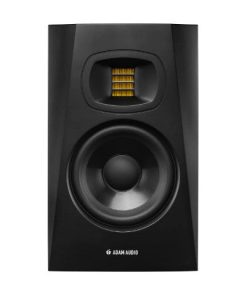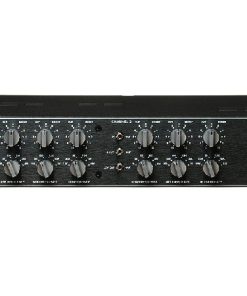SPL Director Mk2 SPL
$ 3.699,00 $ 924,75
The director sets the tone.
The central unit of the HiFi system is the preamplifier. With remote source selection and volume control, tape monitor path, retro-look-VU-meters, premium DA-converter and the all superior VOLTAiR technology, the Director Mk2 caters for musical blockbusters.
Milled from solid
The massive 45mm volume control knob milled from aluminum is a haptic highlight. Its mass together with the motorized Alps RK27 “Big Blue” potentiometer enhances the “spoon in the honey” feeling even further.
The red marker LED ensures good visibility of the volume parameter even in darkened environments.
Remote control
The volume control can be remotely controlled with any infrared remote control.
The Director Mk2 learns to communicate with it with the simple push of a button.
Learning made easy
This video explains how you can use any infrared remote control to remotely control the volume and the source selection.
Source of joy
Up to ten (10!) stereo sources can be connected to the Director Mk2. Six of them are for analog and four for digital input signals.
The source selection is shown in the dot matrix LED display: IN 1 through IN 6 for the analog inputs.
AES, USB, COAX, OPTIC for the digital inputs, where the detected sample rate is displayed after about two seconds. For example U768 = USB input with 768 kHz sampling rate.
The source selection can also be operated remotely if the rotary switch is set to the “Remote” position.
The Director Mk2 offers two pairs of balanced inputs with XLR connectors and four standard inputs with gold-plated RCA connectors.
On the digital side there are four additional inputs. PCM audio is received in S/P-DIF format via coaxial Cinch, optical Toslink and balanced XLR (AES). Both PCM audio and DSD audio can be converted via USB.
Well informed
The DAC automatically picks up the sampling rate and resolution of the digital playback source. No matter if a streamer, computer or CD player is connected. No further settings on the Director Mk2 are necessary.
The detected sampling rate is shown in the dot matrix LED display. For example, U768 is an acronym for the source “USB” with a sampling rate of 768 kHz.
The DAC768
The highly acclaimed AKM AK4490 Velvet Sound™ premium DAC chip is used as the converter chip in the digital-to-analogue converter, which thanks to its architecture reproduces the finest sound details.
It converts PCM audio with a resolution of 32 bits and a sampling rate of up to 768 kHz, which is equivalent to 16 times CD resolution. Direct Stream Digital is also supported up to a resolution of DSD4 or DSD256. In contrast to the DAC 768xs, the DAC768 not only offers an AES/EBU digital input, but also the SPL DLP120 with VOLTAiR technology.
The DLP120 (Dual Low-Pass)
The analog output of the DAC chip must be filtered by a low pass filter. Phonitor xe has two of them: One for PCM audio and one for DSD audio, since different roll-off frequencies are required.
In contrast to all other DACs in the world, the low pass filters here are built using VOLTAiR technology, which provides a plus in dynamics and headroom and sound.
Good ol’ times
Two mechanical VU meters visualize the input levels for the left and right audio channel.
With the VU switch you can optimize the display for different signal levels.
Tape Monitor
A tape monitor circuitry is quite retro.
Who still owns a cassette recorder or a tape machine?
Who else loops in an equalizer?
To put it another way:
Who would like to do it and cannot do it because no manufacturer offers a tape monitor circuit anymore?
Well, those who want can again.
Today’s audio levels are much higher than in the past and many recorders will be overloaded by them.
In that case simply press the switch and the level to the recorder is lowered by 10 dB.
To compensate, the level from the recorder is increased by 10 dB. Et voilà.
All variable – or Slave Thru?
The Director Mk2 provides two stereo output pairs for connecting power amplifiers or active loudspeakers.
One pair of outputs with XLR, the other with RCA outputs. Both have the same output signal, which is controlled by the big volume control. Thus, a pair of speakers can be fed via one stereo output and a subwoofer via the second stereo output. The playback volume for both stereo outputs is adjusted together via the volume control on the Director Mk2.
With a DIP switch on the back of the device, the volume control for the RCA and XLR outputs can separately be switched out of the signal path – this makes the respective output a “Slave Thru” output to e.g. connect a headphone amplifier with its own volume control. The volume control of the Director Mk2 no longer affects the playback volume of the connected headphone amplifier when a stereo output’s Slave Thru mode is active.
Home Theater Bypass
Since the hardware revision 2.2, the Director Mk2 features a Home Theater Bypass function. This allows the Director Mk2 to be used in combination with a multi-channel home theater system. The L and R channels of the home theater system can be simply connected to Input 6 of Director Mk2. When the Home Theater Bypass is active (DIP 4), Input 6 is no longer affected by the volume control of the Director Mk2.
Everything under control – AMP CTL
The standby mode of devices with 12V trigger input, can be switched on and off via AMP CTL, together with the Director Mk2. This allows, for example, the SPL Performer s800, Performer m1000 or Performer s1200 power amplifiers to be ideally integrated into the set-up.
| Color Options | Black, Silver, Red |
|---|
Prompt Delivery and Professional Packaging
Our long-standing partnership with UPS FedEx DHL and other global carriers lets us offer a range of shipping services. Our warehouse staff is extremely skilled and will package your items according to our precise and exact specifications. Your goods will undergo an extensive inspection and be safely packaged prior to being sent out. Each day, we ship to thousands of customers in many countries. The fact that we are committed to becoming the biggest online retailer in the World is clear. These warehouses are in Europe in the same way as they are in USA.
Note: Orders that include more than one item are assigned a processing period depending on the item.
Before shipping, we will inspect thoroughly the items you have ordered. Most orders are shipped within 48 hours. Expected delivery time is between 3-7 days.
Returns
Stock is dynamic. It's not entirely managed by us since we are involved with multiple entities, including the factory and the storage. The actual stock can change at any moment. It is possible that your order may be out of stock once the order has been placed.
Our policy lasts for 30 days. We cannot exchange or refund your order if it has been 30 days from the date of purchase.
For your item to be returned it must be in its original packaging, unopened and in the condition you received it. The item must be in its original packaging.
Related products
Accessories
Subwoofer
Mic Preamp
Monitor Systems
Monitor
Accessories
Monitor
Monitor Systems
Monitor Systems
Monitor Systems
Subwoofer
500 Series
Equalizers
Recording Equipments
Microphones
Microphones
Recording Equipments
Monitor Systems
Microphones
Monitor
Monitor
Monitor
Equalizers
Microphones




































































